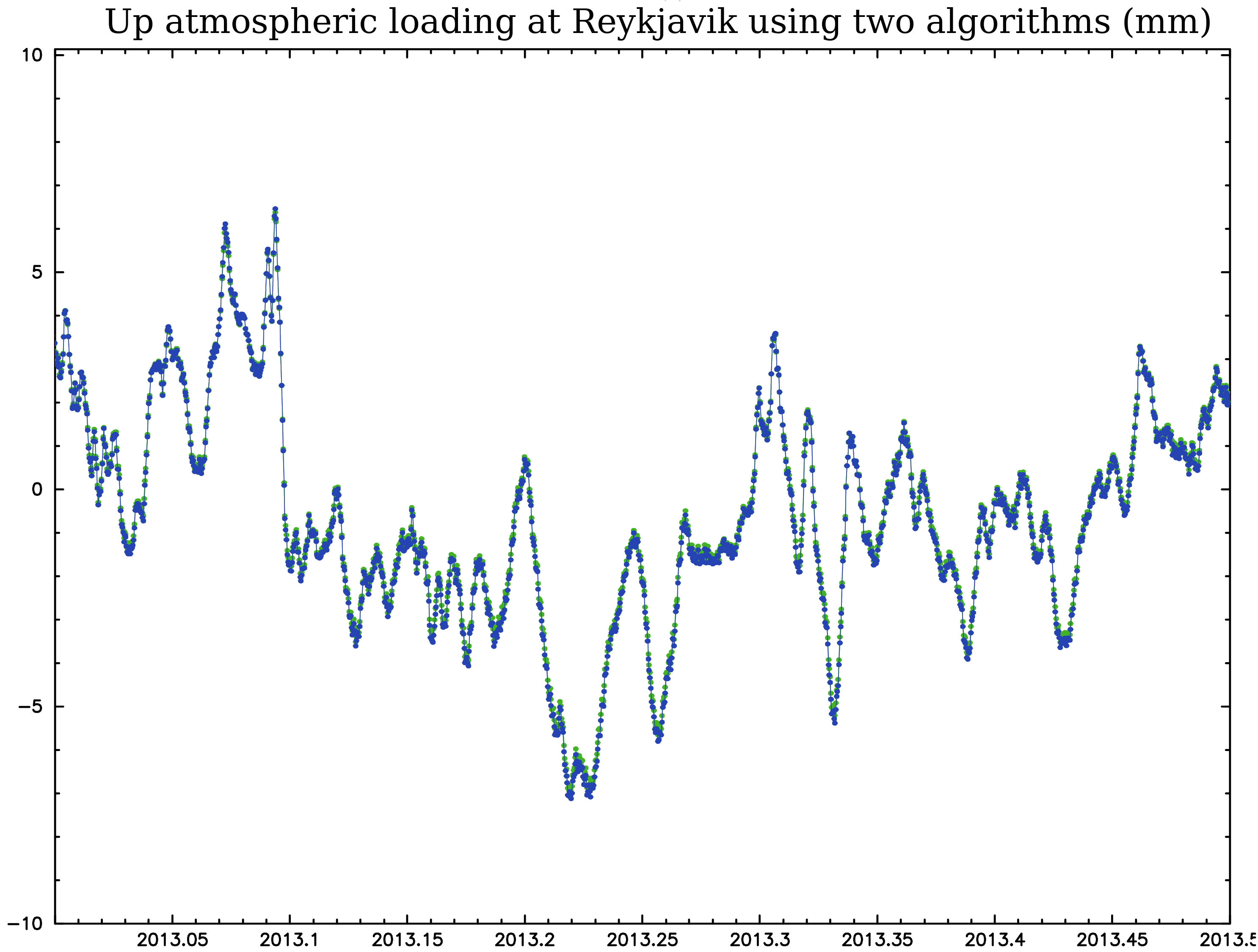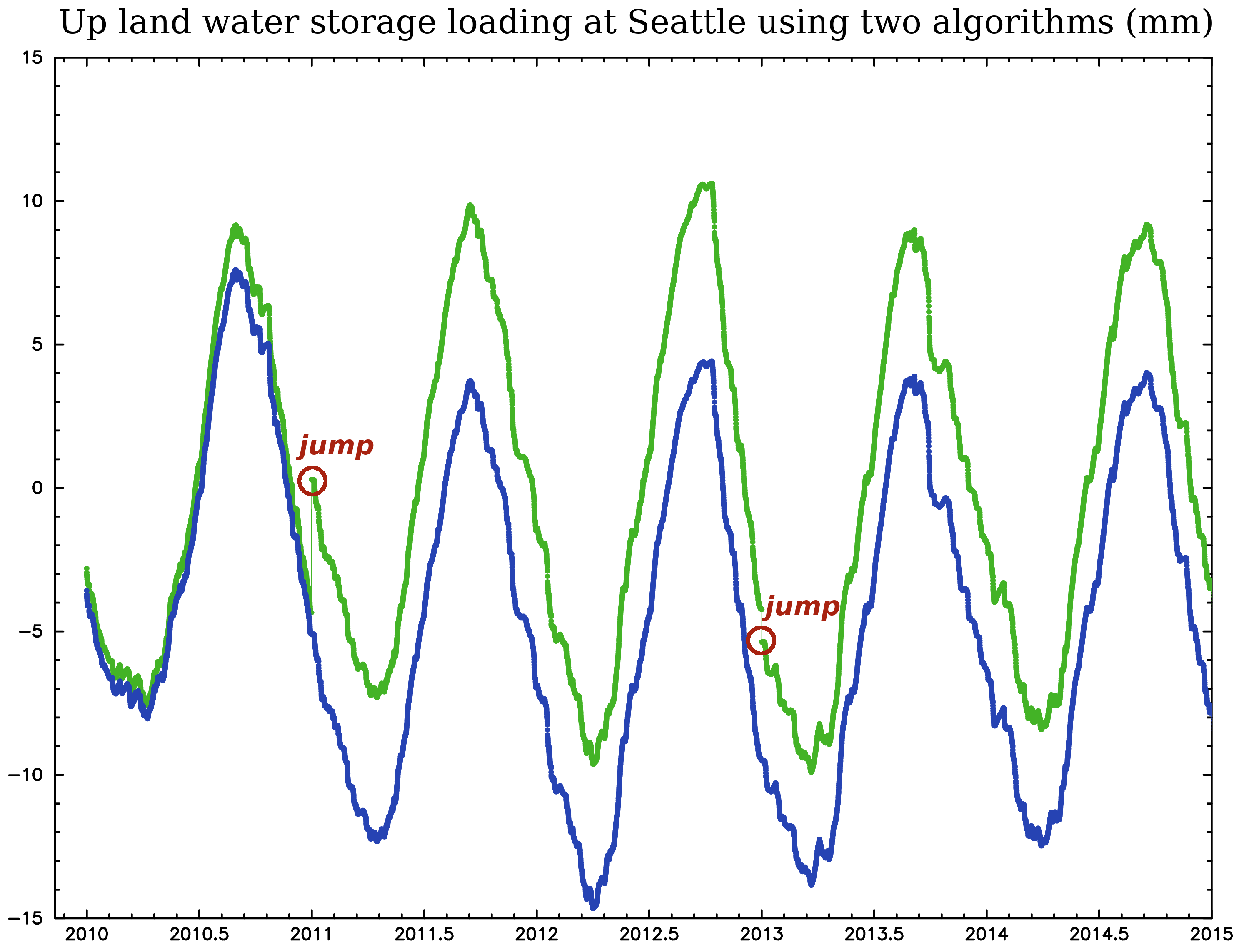[an error occurred while processing this directive]
Transition of the mass loading service in June 2017
List of changes:
-
The algorithm of mass loading computation was changed. The algorithm
of the 3rd generation service included 1) spherical harmonic transform
of the pressure fields anomaly; 2) multiplication it with
h'n/(2n+1) and l'n/(2n+1) factors,
where h'n and l'n are loading Love numbers;
3) storing the scaled spherical harmonics transform coefficients;
4) computation of loading displacements for a given station using
the set of these coefficients. When loading at the 0.25° × 0.25°
regular grid was computed, these grid elements were treated as "stations".
The degree/order of the spherical; harmonics transform is 1023
(9.8 × 9.8 cos φ km grid). The spacial resolution of the
0.25° × 0.25° grid was
not sufficient for interpolation within 100 km of the coastal line.
The algorithm of the 4th generation service included 1) spherical harmonic
transform of the pressure fields anomaly using Driscoll-Healy sampling
theorem; 2) multiplication it with h'n/(2n+1) and
l'n/(2n+1) factors, 3) multiplication with the Blackmann window
function; 4) inverse vector spherical harmonics transform that produce the
gridded displacement field; 5) applying sampling correction that mitigate
loading distortion within 1–4 cells of the coastal line; 6) storing
the scaled spherical harmonics transform coefficients; 7) expansion the
global displacement field into 2D B-spline basis; 7) storing the compressed
coefficients of the expansion; 8) computing loading displacements at a given
station with B-spline interpolation using the stored coefficients.
The degree/order of the spherical; harmonics transform is 2699, i.e.
the 2′ × 2′ regular longitudinal/latitudinal grid
(3.7 × 3.7 cos φ km resolution).
- Main motivations of the changeover:
- loading computation for satellite altimetery;
- improvement of accuracy near the coastal line;
- to develop the algorithm with known errors of loading
integration. (It was shown that the maximum error
of loading integration is 0.2 mm for ocean loading and below
0.1 mm for all other loadings.)
- Support of the following models was removed: MERRA-1, GEOS-FP, NOAH025,
GOT-48, FES2012.
- Support of the following models was added: MERRA-2, GOT-410C, FES2014B,
EQUIL01, EQUIL02. The previous version added oceanic pole tide, Sa,
and model tides to GOT-48 and FES2012. The new version treats the
equilibrium and dynamic zonal ocean tides separately.
- The previous version had wrong sign for FES2012 zonal ocean tides.
For historical reasons the phase of zonal ocean tides has additional
π term with respect to solid tide. This additional π phase is
subtracted in the current version, but not corrected in the previous
version.
- Jumps in land water storage surface pressure GEOS-FPIT (4 jumps) and
MERRA2 (3 jumps) were estimated and eliminated from these models.
As a results, the new mass loading series loading series do not have
jumps.
- The coefficients of B-spline loading field expansion are made public
and are downloadable.
- The limit of the number of stations for the on-demand service lifted from 256
to 16384.
- The file naming convention was changed.
to 16384.
Here are example of differences of loading computation using different
algorithms and same models:


The differences in land water storage loading are mainly due to jumps in
the soil moister models GEOS-FPIT. It affects the loading displacements
computed with the previous algorithm (green points) and does not affect
displacements computed with the new algorithm (blue points).
Back to the International Mass Loading Service
[an error occurred while processing this directive]


